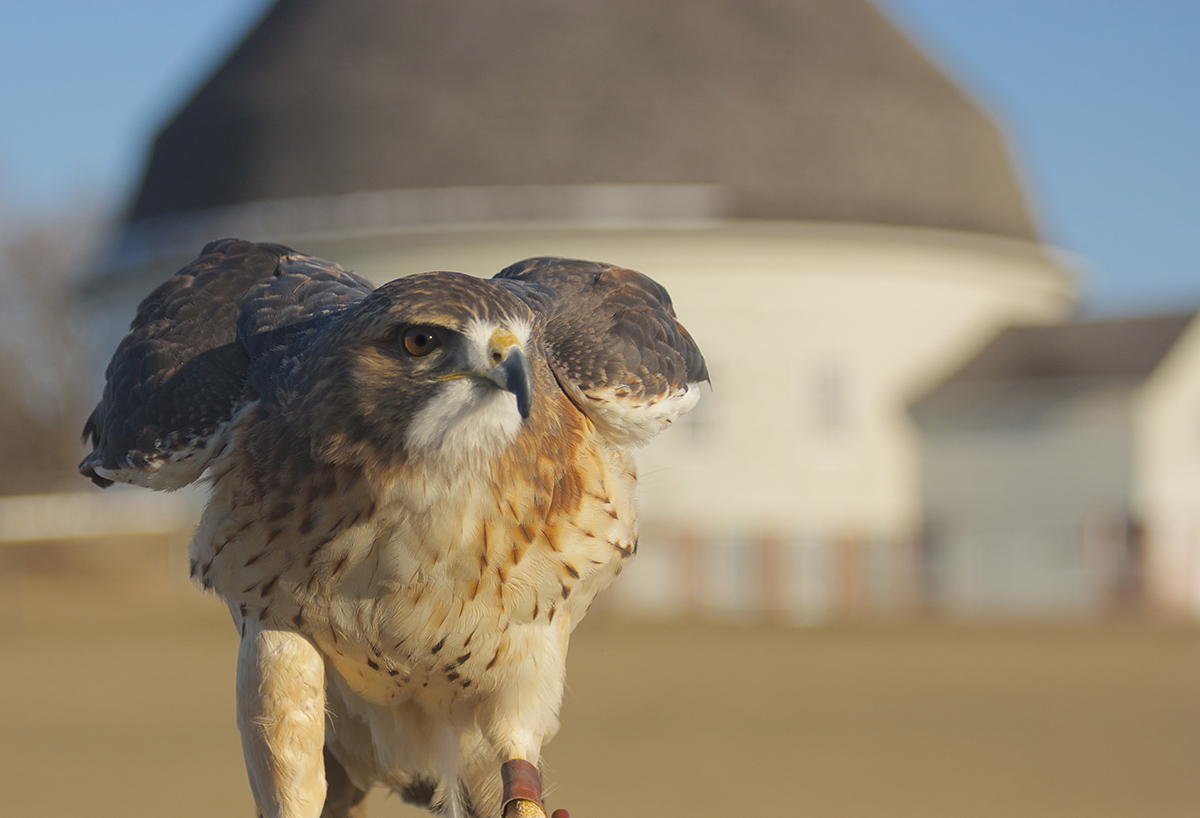
Meet our Ambassador Animals
Odin
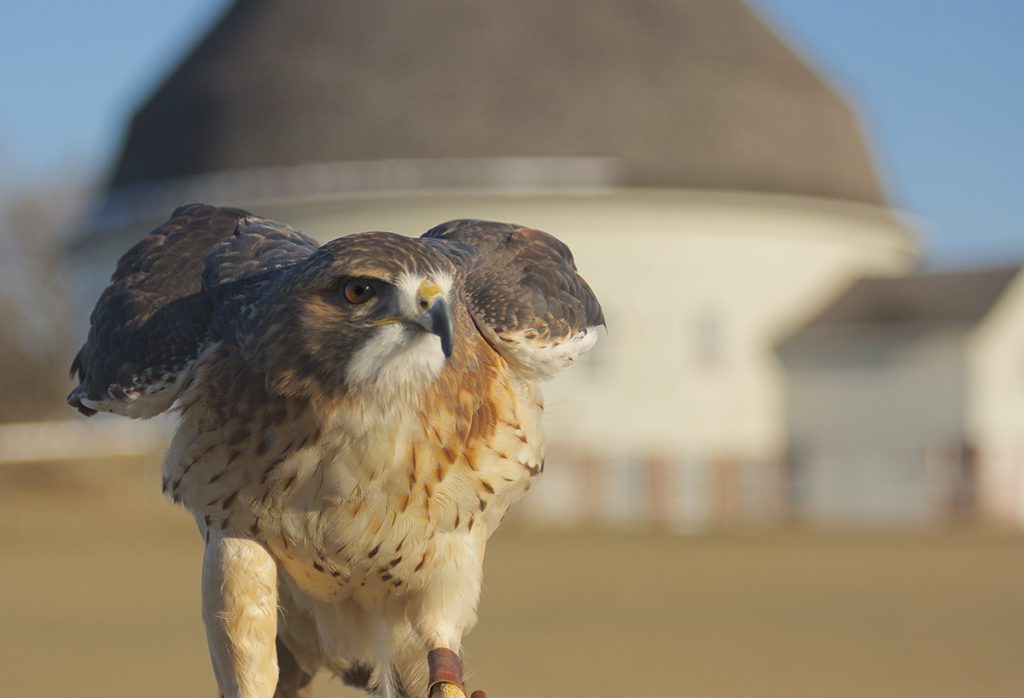
Odin is our resident male Red-Tailed Hawk (Buteo jamaicensis), was found in Fairbury, Illinois. He was presented to the Wildlife Medical Clinic as an extremely weak, emaciated, and dehydrated juvenile on August 15, 1997. Upon arrival, he was given an emergency administration of fluids via an intraosseous catheter (a bone catheter), which is both the most efficient and most reliable way to give emergency fluids in critical animals. This emergency administration saved Odin’s life. He recovered after a few months, with his health improving drastically and his musculature filling out quite nicely. However, as with every procedure, there is a chance for complications to occur. In Odin’s case, while we are not quite sure of the reason for the complication, the joint where the intraosseous catheter was placed developed a bone infection. While the infection was resolved, he was left with arthritis that prevented the full extension of his right wing. Without full extension, he cannot fly or survive in the wild. Therefore, he is now a permanent resident and ambassador for the Wildlife Medical Clinic.
Fun Facts: Red-Tailed Hawks usually develop their famous red tail between 2-3 years old, and are one of the largest birds in North America. Their shrieks are also quite magnificent; so much so, that most movies and TV shows use the cries of a Red-Tail Hawk for any eagle or hawk that appears on-screen!
Ruby
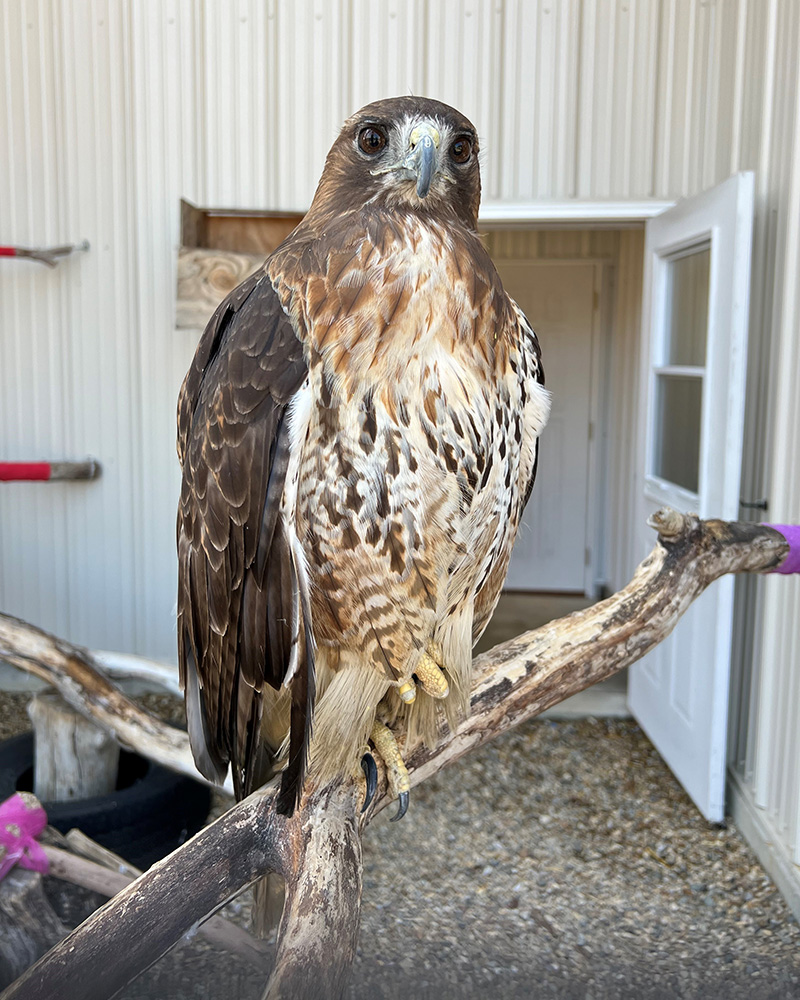
Ruby, our female resident Red-Tailed Hawk (Buteo jamaicensis), was found walking up to people asking for food. Because of this uncharacteristic behavior, a member of the public called the Illinois Raptor Center (IRC), where she was declared physically healthy. Unfortunately, she was too habituated to humans to be releasable. Due to her calm demeanor and overall good health, she was a good candidate to become a Wildlife Ambassador for her species at the University of Illinois.
Fun Facts: Red-Tailed Hawks usually develop their famous red tail between 2-3 years old, and are one of the largest birds in North America. Their shrieks are also quite magnificent; so much so, that most movies and TV shows use the cries of a Red-Tail Hawk for any eagle or hawk that appears on-screen!
River
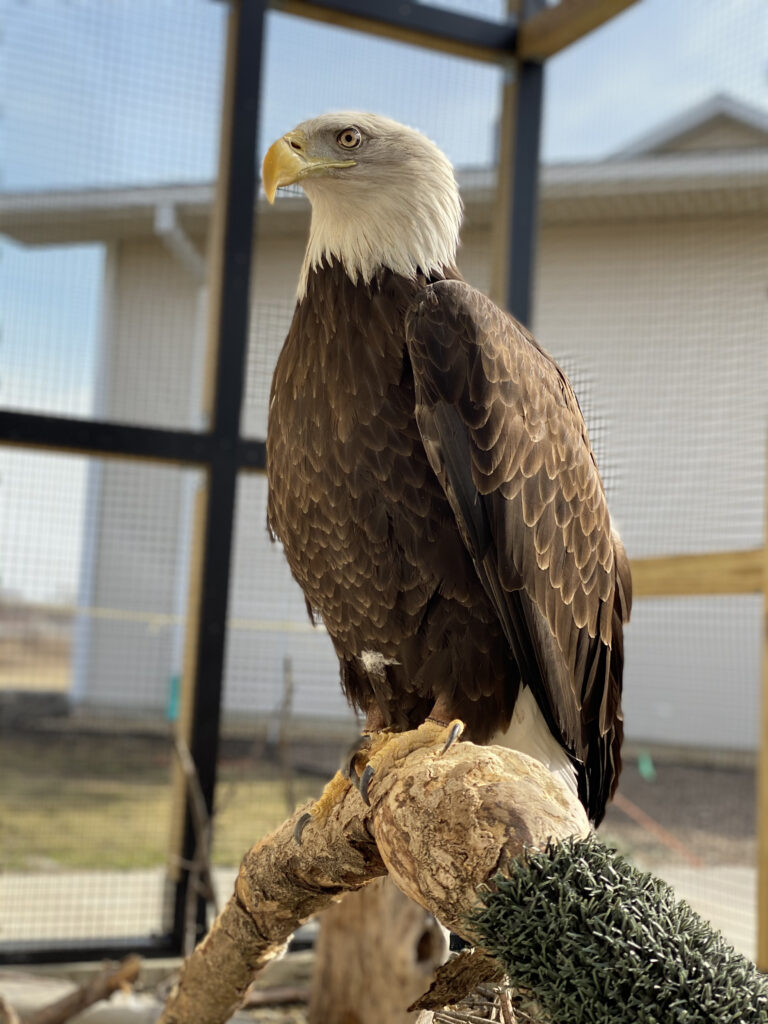
River, our resident Bald Eagle (Haliaeetus leucocephalus), was transferred to the Wildlife Medical Clinic from Wildlife Prairie Park on the morning of March 15, 2015. She presented as an approximately 4-year-old, near-adult Bald Eagle. Before being brought to Wildlife Prairie Park on March 14, 2015, she was found struggling to stay afloat in the Illinois River. Upon presentation to our clinic, it was noted that she had a severe fracture of the forearm bones in her right wing, with the end aspect of the wing wrapped 3 times around itself. Upon arriving at the Wildlife Medical Clinic, River underwent multiple surgeries in order to remove necrotic tissue. Unfortunately, she lost nearly half of her right wing due to necrosis—but otherwise, she healed well! However, with only half of one wing, she can no longer fly and survive in the wild. After she was nearly healed, she was transferred outside to our flight cage enclosures so that she would have more room to move around while we searched for a forever home for her.
As we were searching, one of our veterinarians began working with her to help minimize her fear of humans. The results were incredible—she was calmer than expected when the veterinarian was in close proximity to her (what the eagle would consider their “territory”) when cleaning her enclosure. River would also, cautiously come near, or step up onto glove, to accept food offered from forceps (tweezers). Since she was responding to human proximity and training, we applied for a permit in late 2015 to keep her as an official ambassador of the Wildlife Medical Clinic after being unsuccessful at finding a forever home for her.
River has made great strides in the years we have had her in our care. While she is still slow to warm up to new people, once she knows you, she is quite calm and even curious, sometimes approaching and perching where asked. While she doesn’t come out on the glove during programs, she is visible in her outdoor enclosure and helps to educate visitors about the challenges that eagles face in the wild.
Fun Facts: Bald Eagles are not actually bald; rather, their head feathers are a different color (white) compared to the rest of their body (dark brown). They receive their full, white heads at around 5 years old; before then, their heads are mainly composed of brown feathers, like the rest of their body. Bald Eagles are the national bird of the United States, and are one of the largest birds in North America. While they are fierce hunters, they are also known to rob other birds of their hard-earned prey catches! They used to be endangered, but were taken off of the endangered species list in 1995, and now just remain a protected species.
Vara
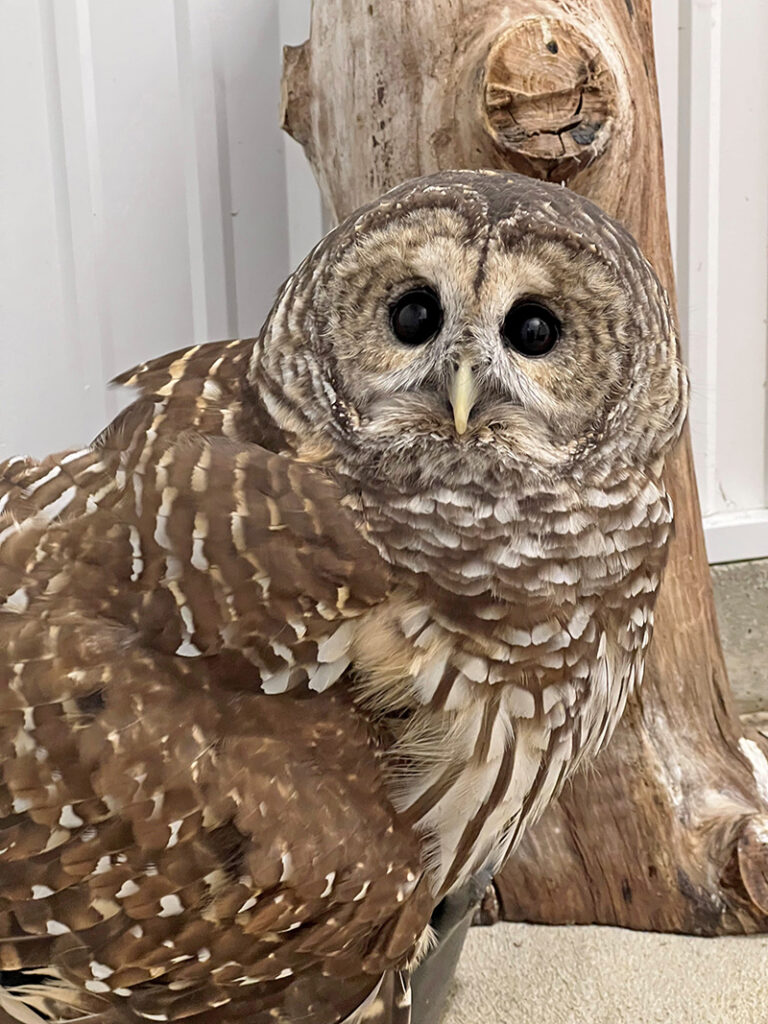
Vara is our resident Barred Owl (Strix varia), was found in Tuscola, Ill. She presented to the Wildlife Medical Clinic in March of 2017 as an adult unable to fly. After medical tests, it was determined that she has a very old fracture near the shoulder. Due to the proximity to the joint and the age of the injury, she was not a candidate for surgery. She was sent to the local raptor facility to flight test, as she was non-painful and otherwise healthy. Unfortunately, she was returned after being deemed non-flighted and non-releasable. Due to her unusually calm and docile personality, she was accepted into the ambassador program. She still has a long way to go before being seen out on events, but is on display at the veterinary school. She has made a tremendous amount of progress already, and her small team of trainers is committed to ensuring that she feels comfortable and secure at all times. Her name comes from the scientific name and has Latin origins, meaning “different” or “stranger.”
Fun Facts: Barred Owls are known for their instantly recognizable “Who cooks for you? Who cooks for you-all?” call. Young Barred Owls can climb trees by grasping the bark with their beak and talons, flapping their wings, and walking up the trunk.
Hazel
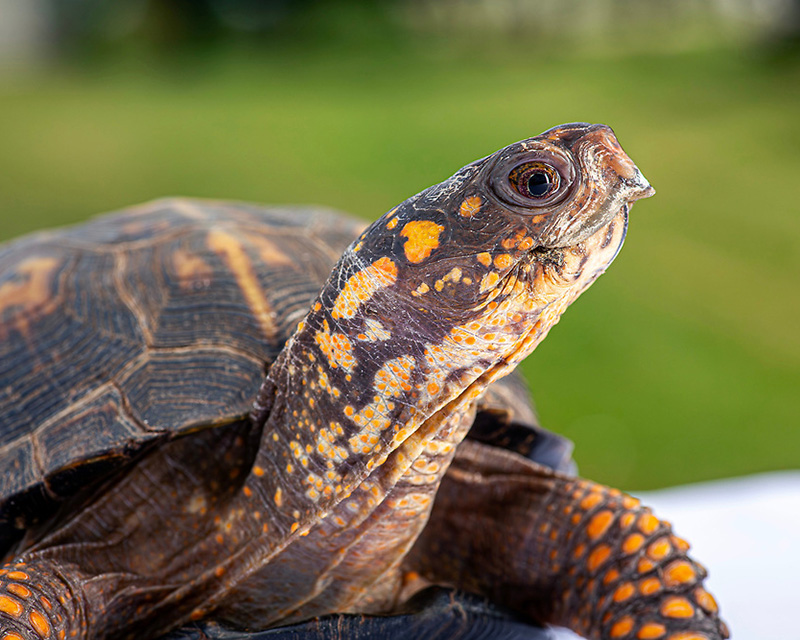
Hazel is our resident Eastern Box Turtle (Terrapene carolina carolina ), was brought in February 10, 2017. She had been taken from the wild as a baby and received inefficient lighting and diet for nearly two years. This resulted in a bacterial infection in her toes and nutritional deficiencies. She was surrendered to the clinic when her front toes began falling off. After two months of intense treatment, appropriate lighting, and a balanced diet her condition improved. Due to her habituation to humans, unknown origination, and missing toes that could inhibit proper burrowing, Hazel was accepted into the ambassador program. She makes a great addition to our program as our only native reptile because she will help spread reptile education and awareness out to the public, which will transmit respect for local wild reptiles in Illinois. Additionally, she will help raise public awareness about the dangers of “adopting” wild animals.
Fun Facts: Eastern Box Turtles get their name because they can fully close their shelling, creating a box-like shape. Males often have red-orange irises, whereas females often have brown or hazel colored eyes.
Onslo
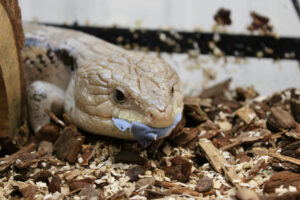
Onslo, our resident Blue-Tongued Skink (Tiliqua), is one of our reptile and non-native residents. Onslo’s previous owner was Rose Ann Meccoli, who worked in the Wildlife Medical Clinic for over 15 years. She was also very involved in our ambassador program during that time. Rose Ann passed away in March 2015, and Onslo was then given to the clinic to become a member of our Education and Outreach Program. While not an Illinois-native, or a previous wild animal, Onslo makes a great addition to our program because he helps spread reptile education and awareness to the public, which will transmit respect for local wild reptiles in Illinois. Additionally, he will also help diffuse the fear and misconceptions surrounding many reptile species.
Fun Facts: Blue-Tongue Skinks are reptiles from Australia that have a long, flat body, with short legs that help them live on the ground in forests. As the name suggests, their tongues really are blue in color, which they flash to predators when they are feeling threatened. The bright blue color frightens the predators, making them think that the skink is poisonous. Blue-Tongued Skinks are omnivores, eating fruits, vegetables, and insects.
Petunia
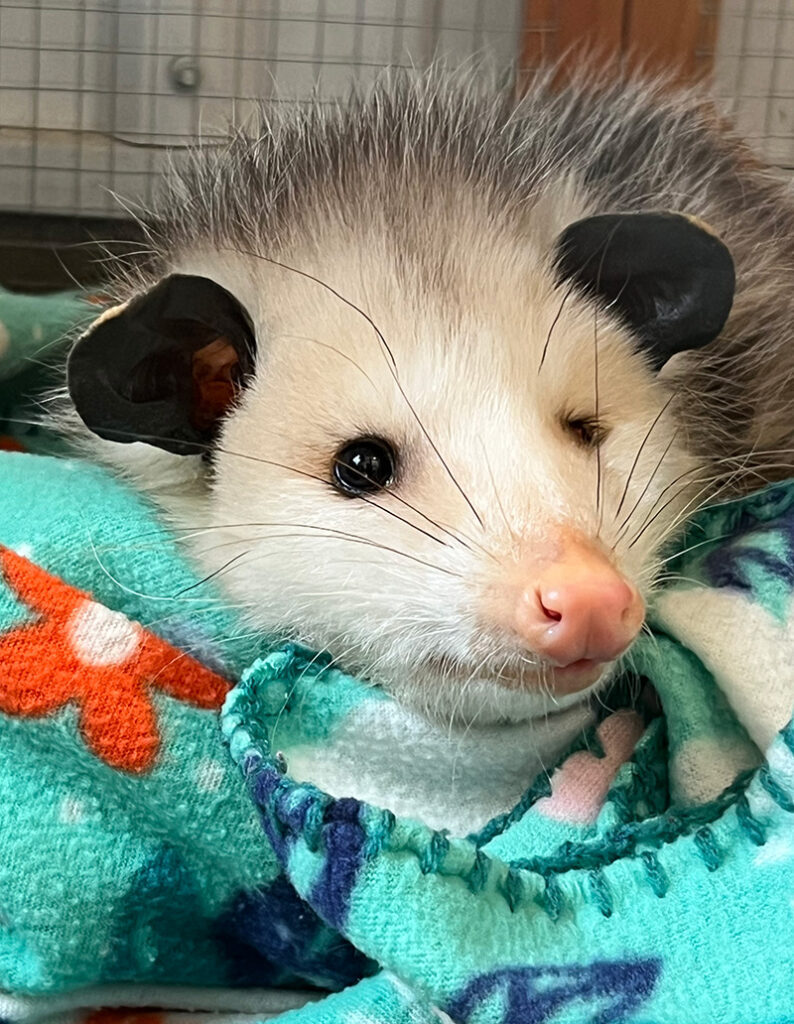
Petunia, our resident Virginia opossum (Didelphis virginiana), was brought to the Wildlife Medical Clinic from Champaign, Ill., on May 18, 2022, as a joey. A good Samaritan rescued her and her siblings after their mother was hit by a car. While her siblings were able to be transferred to a Licensed Wildlife Rehabilitator to be released when they were old enough, Petunia stayed behind because she was missing her left eye. Based on her age, this is most likely a birth defect, not an injury. In any case, it leaves her vulnerable to predators and affects her depth perception, making her unlikely to survive in the wild.
Due to her young age and good health, she was selected to become a Wildlife Ambassador. At the WMC, she was initially fed several times a day with formula, then transitioned onto solid food when she was old enough, all while being acclimated to spending time around humans. Petunia’s trainers work with her daily to ensure she is comfortable with her training and basic behaviors such as standing on the scale for weighing, wearing a harness and leash for walks, and minimal handling for veterinary checks and routine nail trims. Petunia also goes for daily walks which has been great for preparing her for outreach events. Petunia is very comfortable at outreach events and does a great job of representing her wild counterparts and showing the importance of opossums in the environment.
Fun Facts: Opossums have fifty teeth which is the most teeth of any North American land mammal! Opossums are often shown hanging by their tails in movies and other depictions, but this is not common, especially in adult opossums. Instead, tails are used for balance and collecting nesting materials. If an opossum joey is found without its mother, mom is NOT coming back (opossums always stay with their offspring and cannot tell if one is missing). The joey should be taken to a licensed wildlife rehabilitator as soon as possible.
Caduceus
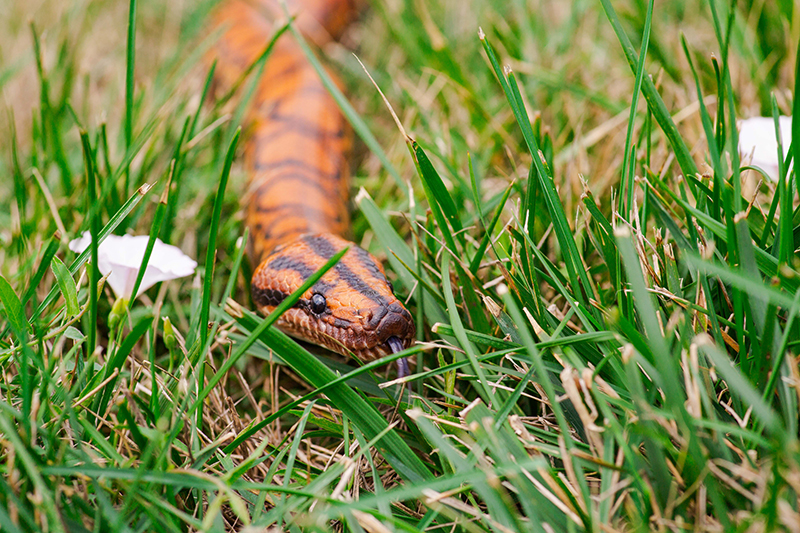
Caduceus is our resident Brazilian Rainbow Boa (Epicrates cenchria). She was a pet that was donated to the College of Veterinary Medicine in 2012. For 11 years, she was cared for by the Non-Traditional Species Club. In 2023, she became a Wildlife Medical Clinic ambassador when our previous snake retired from public duties.
Because she has a very mild temperament and is very comfortable being around people and being handled, she makes an excellent ambassador animal. While she is not native to Illinois, she will help us educate the public and dispel the fears and misconceptions surrounding snakes and other reptiles that are Illinois natives.
Fun Facts: Brazilian Rainbow Boas are native to the forest floors of South America. They get their name from their iridescent or rainbow-hued skin, which is caused by tiny ridges on the scale surface that refract light. In most snake species, females are bigger than males. Brazilian Rainbow Boas can grow to be four to six feet in length. Caduceus, an adult female, is close to six feet long and weighs around five pounds.
In Loving Memory of our Past Ambassadors
Thistle
Thistle was our resident American Kestrel (Falco sparverius), found in Allerton, Ill. She was presented to the Wildlife Medical Clinic as a juvenile with a corneal perforation injury in her left eye during the summer of 2012. Veterinarians attempted to save her left eye, but the injury unfortunately rendered her blind in that eye—leaving Thistle with only one working eye. Unlike owls, which rely heavily on their hearing to hunt, falcons (the family which kestrels are a part of) rely on their eyesight to hunt; therefore, Thistle could no longer survive in the wild, so the Wildlife Medical Clinic received permission for Thistle to join our ambassador program. Thistle was extremely curious and interactive; everything was a toy in Thistle’s eyes! She loved watching clinic members, participating in her daily training and enrichment plans, and having new objects put in her enclosure. Thistle was a delight to work with and touched the lives of many students, faculty, staff, and visitors during her eleven years at the Wildlife Medical Clinic and will be greatly missed.
Fun Facts: American Kestrels are the smallest falcons of North America, but don’t let their size fool you—they are extremely fierce hunters! American Kestrels are sexually dimorphic, meaning that you can physically see the differences between males and females. We know that Thistle was a female due to her rusty-red coloring, whereas males typically have much more silvery-blue coloring throughout their feathers. Both sexes have black vertical bars on their face termed “sideburns”, which help deflect the sun’s rays during flight. In addition to having extremely sharp vision, falcons can also see more colors than humans, and can even see the ultraviolet color spectrum!
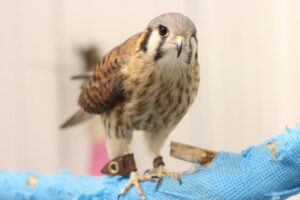
Bucket
Bucket retired as our resident Ball Python (Python regius) ambassador in January of 2023. She is a non-native species that was donated to our program by one of the Wildlife Medical Clinic’s veterinarians. Her previously being a pet made her a great candidate to be an ambassador as she was very curious and sociable with humans; she loved exploring and interacting with clinic volunteers! While not an Illinois-native or a previous wild animal, Bucket made a great addition to our program because she helped spread reptile education and awareness out to the public, which translated into respect for local wild reptiles in Illinois. Additionally, she helped to diffuse the fear and misconceptions surrounding snakes and other reptile species.
Over the last seven years, Bucket was an integral part of our outreach programs and taught many people about snakes and their role in the environment. During this time, Bucket became less tolerable of being handled for programs. After evaluating the situation, the team decided to rehome Bucket to provide her with a place to feel safe and protected where she would not have to be handled as frequently. Now, she lives with one of our current program coordinators and is doing very well in her new home. Thank you to everyone who came to learn about Bucket and her species during her time in the program. We are glad that she was able to make an impact on the community and increase awareness and compassion toward our legless friends!
Fun Facts: Ball Pythons are native to sub-Saharan Africa and are non-venomous constrictors. On average, they grow to be 4-5 feet long, and can live for more than 30 years. They are aptly named as when threatened, they will ball up and place their head in the middle of the ball and cover it with their body to protect themselves from whatever is threatening them.
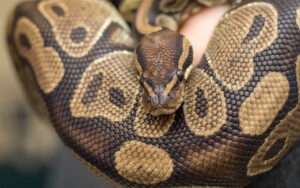
Patty
Patty was our Virginia Opossum (Didelphis virginiana) ambassador animal. She was found as a joey in 2020 and cared for by a well-meaning individual for a year. Patty then developed signs of illness and was surrendered to the Wildlife Medical Clinic in 2021, to receive lifesaving medical care. Patty was suffering from pyovagina, a dangerous infection in her reproductive tract that can lead to septicemia (a blood infection). The doctors and students at the WMC successfully performed a surgery to treat her ailments and get her on the road to healing.
Patty was also extremely overweight, thus once she recovered from her surgery, her weight loss journey began with the help of our rehabilitation service here at the Veterinary Teaching Hospital. While Patty’s friendly and human-centric behaviors meant she could never be released into the wild, they are also what made Patty such a great ambassador in our program! She helped to educate the community on the consequences of keeping wildlife as pets and simultaneously dispelled some of the negative connotations often associated with this ecologically valuable species!
Unfortunately, we began to see age related health issues with Patty and while we managed these for some time, it was clear that they were getting worse. Due to this and her increasing age, the difficult decision was made to humanely euthanize her in July of 2023. Patty was a huge part of our ambassador program and is greatly missed.
Fun Facts: Virginia opossums are the only marsupial to live north of Mexico. Their tails are adapted for grasping and wrapping around things to hang for short periods of time; one untrue myth is that they sleep hanging from their tails. Females have enough teats to support thirteen offspring, and commonly have seven to eight joeys at a time. The joeys stay in their mother’s pouch continuously for 55 to 60 days and spend another four to six weeks on their mother’s back before they are ready to be off on their own. Female opossums can have up to three litters a year.
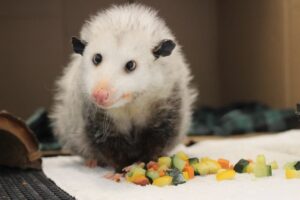
Derby
Derby, our resident Eastern Screech Owl (Megascops asio), was a beloved member of our ambassador program after being transferred to the Wildlife 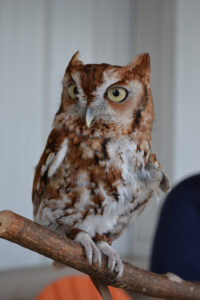 Medical Clinic from the Raptor Rehabilitation of Kentucky, Inc., in March, 2015. Her left wing was slightly drooping, and, upon reviewing radiographs taken, it was noted that this droop was due to multiple fractures in her wing’s forearm bones.
Medical Clinic from the Raptor Rehabilitation of Kentucky, Inc., in March, 2015. Her left wing was slightly drooping, and, upon reviewing radiographs taken, it was noted that this droop was due to multiple fractures in her wing’s forearm bones.
Unfortunately, by the time we received Derby, the fractures were too far along in the healing process for us to attempt to fix so that she could regain full flight. As a result, Derby could not fully fly. Due to her unusually calm demeanor, she was an ideal candidate for our Education and Outreach Program.Over the last few years, Derby was a star member of our resident ambassador education team. She could be seen everywhere from daily walks with her trainers on the veterinary medicine campus to events with local schools, groups, and businesses, and even on local television. While occasionally grumpy, as all screech owls can be, she took to training and interactions with both our volunteers and the public naturally.
Unfortunately, over the 2018 Thanksgiving holiday, Derby rapidly deteriorated without recognizable clinical signs and quietly passed away. As so often happens in wildlife medicine, her necropsy (animal autopsy) results were inconclusive, and we will never know the exact circumstances that lead to her passing. She is greatly missed by all who got to know her, handlers and public alike.
Fun Facts: Eastern Screech Owls have two different morphs—a grey morph and a reddish-brown (rufous) morph. The grey morph is much more common, with nearly two-thirds of the screech owl population being a grey morph. Regardless of the morph, the feather pattern that screech owls share help them blend into trees almost flawlessly, allowing them to nest and hunt while nearly invisible.
Noel
Noel, our resident Northern Saw-Whet Owl (Aegolius acadicus), was a wonderful member 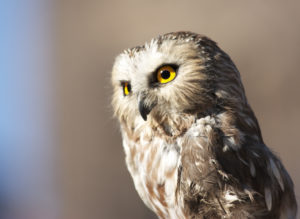 of our ambassador program for nearly 10 years. She was found in Alvin, IL, and brought to the Wildlife Medical Clinic on December 5, 2006, with no function, or feeling, in her left wing. No fractures were seen on X-rays, and it was later determined that an injury had caused irreversible nerve damage to the wing. Due to this injury, Noel could no longer fly, and, therefore, could no longer survive in the wild. Fortunately, the clinic was able to obtain permission for Noel to join our Ambassador Raptor Program. She was unique in being our only ambassador that came into the clinic as an adult as opposed to a juvenile, and, due to that, we are unsure as to exactly how old she was. She had a surprisingly mild disposition for an adult owl, and this disposition was ideal for behavioral training and use in educational presentations. To our great sadness, Noel passed away on September 29, 2016 from natural causes. She was extremely old for her species, and was found peacefully at rest. She will be incredibly missed.
of our ambassador program for nearly 10 years. She was found in Alvin, IL, and brought to the Wildlife Medical Clinic on December 5, 2006, with no function, or feeling, in her left wing. No fractures were seen on X-rays, and it was later determined that an injury had caused irreversible nerve damage to the wing. Due to this injury, Noel could no longer fly, and, therefore, could no longer survive in the wild. Fortunately, the clinic was able to obtain permission for Noel to join our Ambassador Raptor Program. She was unique in being our only ambassador that came into the clinic as an adult as opposed to a juvenile, and, due to that, we are unsure as to exactly how old she was. She had a surprisingly mild disposition for an adult owl, and this disposition was ideal for behavioral training and use in educational presentations. To our great sadness, Noel passed away on September 29, 2016 from natural causes. She was extremely old for her species, and was found peacefully at rest. She will be incredibly missed.
Fun Facts: Saw-whet owls are one of the smallest owls native to North America (the smallest in Illinois), generally weighing less than five ounces. Few people ever see a Saw-Whet Owl in the wild, due to both their small size and being strictly nocturnal. As with all owl species, a Saw-Whet’s eyes are too large to move in their sockets; their anatomy makes up for this by allowing them to swivel their head ~270 degrees, so that they can still see in all directions.
Mikey
Mikey, our resident Painted Turtle (Chrysemys picta), was an incredible addition to our 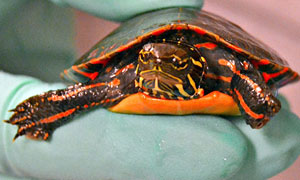 Education and Outreach Program this past year. During his time with us, Mikey traveled to many PR events to educate both children and adults about the importance of wildlife and nature. Mikey was donated to the Wildlife Medical Clinic during the summer of 2015. His previous owner was a grade school teacher that had him as a classroom pet for over 25 years! When Mikey’s owner retired, he was donated to our clinic to become a permanent ambassador. Due to the environment that he had lived in for 25 years, Mikey was very sociable and curious. He loved receiving treats, exploring, watching and interacting with the clinic volunteers, and going outside to soak up some natural UV light. He was a wonderful member of the clinic, and served as an incredible ambassador for his species. Unfortunately, Mikey passed away in May 2016. He will be greatly missed.
Education and Outreach Program this past year. During his time with us, Mikey traveled to many PR events to educate both children and adults about the importance of wildlife and nature. Mikey was donated to the Wildlife Medical Clinic during the summer of 2015. His previous owner was a grade school teacher that had him as a classroom pet for over 25 years! When Mikey’s owner retired, he was donated to our clinic to become a permanent ambassador. Due to the environment that he had lived in for 25 years, Mikey was very sociable and curious. He loved receiving treats, exploring, watching and interacting with the clinic volunteers, and going outside to soak up some natural UV light. He was a wonderful member of the clinic, and served as an incredible ambassador for his species. Unfortunately, Mikey passed away in May 2016. He will be greatly missed.
Fun Facts: Painted turtles are the most widespread species of native turtles in North America. These turtles are aquatic and feed on algae, vegetation and small water creatures, like insects and small fish.
Nokomis
Nokomis, our resident Great-Horned Owl (Bubo virginianus), was a wonderful addition to  our Education and Outreach Program for 12 years. During his time with us, Nokomis taught a countless number of children and adults about the importance of wildlife and nature.
our Education and Outreach Program for 12 years. During his time with us, Nokomis taught a countless number of children and adults about the importance of wildlife and nature.
In April 2003, a local wildlife rehabilitator brought a Great-Horned Owl fledgling, who could not fly, to the Wildlife Medical Clinic. Radiographs revealed a broken right humerus, the largest of the wing bones. Shortly after his arrival, Nokomis underwent surgery to repair his fractured wing. Metal pins were inserted into the bone fragments to hold them in place, and an external fixator was placed on the outside of the body in order to stabilize the pins. He was given antibiotics and physical therapy, and recovered well enough to be sent to a wildlife rehabilitator. However, the rehabilitator sent him back to our clinic for two reasons: firstly, because his right wing was still drooping, and secondly, because he had an unusually docile demeanor for a Great-Horned Owl.
Normally, Great-Horned Owls are very aggressive; they will clack their beaks and hiss when they feel threatened, and readily use their beaks and talons to defend themselves. As Great-Horned Owls are an incredibly territorial species, they must be aggressive to defend their hunting grounds. However, Nokomis was very docile—quite an unusual occurrence for a Great-Horned Owl. He was very curious from the start and loved to watch everything that happened in the clinic from his perch. He became one of our ambassadors after it was determined that his behavior would not allow him to survive in the wild, and he served as a beautiful ambassador for his species during his time here at the Wildlife Medical Clinic. Unfortunately, Nokomis passed away on March 13, 2015. He will be greatly missed.
Fun Facts: Great-Horned Owls are extremely fierce predators. When clenching their talons, an equivalent to 28 pounds is required to open them! They are covered in extremely soft feathers that not only help camouflage and insulate them, but also help them fly nearly silently when pursuing prey. The ‘ear tufts’ on their head are not ears, and are solely display feathers. Owls rely on their incredible hearing to hunt, and actually have misaligned ears (one ear is higher than the other), which allow the owl to obtain a mental picture of the exact location of its prey before swooping down to catch it.
Delphine
Delphine, our resident Virginia Opossum (Didelphis virginiana), was found in Urbana, IL. She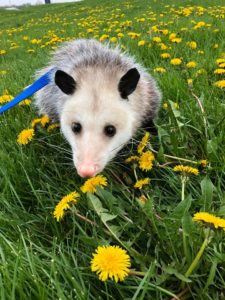 presented to the Wildlife Medical Clinic in September 2017 after a well-intentioned member of the public attempted to rehabilitate her. Unfortunately, she ended up getting too habituated to humans to be releasable. Due to her calm demeanor and overall good health, she was a good candidate to become a Wildlife Ambassador. During her transition, her care team noted a hernia and uneven gait. After further testing, Delphine underwent an FHO to allow pain-free mobility of a previously damaged right hip. This, along with scaring along that same side, lead us to conclude she was likely hit by a car before being found. Her story illustrates how important it is for injured wildlife to be brought to licensed rehabilitators. She makes a wonderful addition to the resident ambassador team as the second mammal in the history of the program. Her name is derived from the Latin name. Sadly, Delphine passed away in January of 2021. She was loved by many and is greatly missed in our hearts.
presented to the Wildlife Medical Clinic in September 2017 after a well-intentioned member of the public attempted to rehabilitate her. Unfortunately, she ended up getting too habituated to humans to be releasable. Due to her calm demeanor and overall good health, she was a good candidate to become a Wildlife Ambassador. During her transition, her care team noted a hernia and uneven gait. After further testing, Delphine underwent an FHO to allow pain-free mobility of a previously damaged right hip. This, along with scaring along that same side, lead us to conclude she was likely hit by a car before being found. Her story illustrates how important it is for injured wildlife to be brought to licensed rehabilitators. She makes a wonderful addition to the resident ambassador team as the second mammal in the history of the program. Her name is derived from the Latin name. Sadly, Delphine passed away in January of 2021. She was loved by many and is greatly missed in our hearts.
Fun Facts: Virginia opossums are the only marsupial to live north of Mexico. Their tails are adapted for grasping and wrapping around things to hang for short periods of time; one untrue myth is that they sleep hanging from their tails. Females have enough teats to support thirteen offspring, and commonly have seven to eight joeys at a time. The joeys stay in their mother’s pouch continuously for 55-60 days and spend another four to six weeks on their mother’s back before they are ready to be off on their own. Female opossums can have up to three litters a year.
